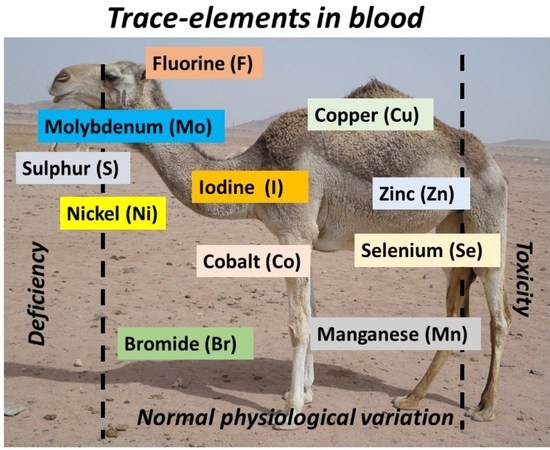Open AccessReview
Blood Trace Element Status in Camels: A Review
by
Mutassim M. Abdelrahman
 Mutassim M. Abdelrahman
Mutassim M. Abdelrahman
Ibrahim A. Alhidary
 Ibrahim A. Alhidary
Ibrahim A. Alhidary ,
,
Riyadh S. Aljumaah
 Riyadh S. Aljumaah
Riyadh S. Aljumaah
Bernard Faye
 Bernard Faye
Bernard Faye
1
Department of Animal Production, College of Food and Agriculture Sciences, King Saud University, Riyadh 11451, Saudi Arabia
2
CIRAD-ES, UMR SELMET, TA/C 112A, Campus International de Baillarguet, 34398 Montpellier, France
3
Faculty of Biology and Biotechnology, Department of Biotechnology, Kazakh National University Al-Farabi, Almaty 050040, Kazakhstan
*
Author to whom correspondence should be addressed.
Submission received: 16 June 2022
/
Revised: 4 August 2022
/
Accepted: 10 August 2022
/
Published: 18 August 2022
Simple Summary
Trace elements are required in small quantities for all species, and their role in many biological functions is essential. Additionally, their deficiency or excess can have important consequences for metabolism and health. Although camels live in ecosystems dominated by minerals, they are also subject to such imbalances. To investigate the trace element status of camels, as for other animals, blood sampling is preferred. The present paper gives a large overview of the values observed in camel blood samples under different physiological and health conditions, as well as some data regarding the symptoms in deficiency or excess situations. The main trace elements involved are copper, zinc, iron, selenium, manganese, cobalt, iodine, fluorine and molybdenum. In addition, some data regarding bromide and nickel, due to their specific mention in the literature, are included. Although the status of sulfur is regarded as intermediary between the main and trace elements, it is added due to its role in polluted areas. Finally, some specificities of camel trace elements are discussed.
Abstract
Trace minerals play an important role in animal health and productivity. They are involved also in many physiological activities, and their deficiency causes a variety of pathological problems and metabolic defects, reducing consequently the animal productivity. The demand for animal products in semi-arid areas is rapidly increasing, and the supply is still below the required level, partially due to low animal productivity. Camels (Camelus dromedarius and Camelus bactrianus) are considered one of the main sources of healthy, high-quality meat and milk for human consumption within most of the countries in the semi-arid regions. Despite their efficient adaptation to their environment, camels can suffer from the growth retardation of newborns, low feed efficiency, anemia, poor fertility, poor reproduction and many other metabolic disorders. It is well known that trace mineral deficiencies and trace mineral toxicities can influence camels’ production and reproductive efficiency, as well as many aspects of their growth and metabolism. Evaluating the trace minerals status of camels and their variability is an obvious step toward improving camels’ productivity and health. Thus, the present article reviews the data regarding the status of trace minerals (copper, zinc, iron, selenium, manganese, cobalt, iodine, fluorine, molybdenum, sulfur, bromide and nickel) in camel blood and their physiological variability, with a focus on their deficiency and toxicity effects.
Share and Cite
MDPI and ACS Style
Abdelrahman, M.M.; Alhidary, I.A.; Aljumaah, R.S.; Faye, B.
Blood Trace Element Status in Camels: A Review. Animals 2022, 12, 2116.
https://doi.org/10.3390/ani12162116
AMA Style
Abdelrahman MM, Alhidary IA, Aljumaah RS, Faye B.
Blood Trace Element Status in Camels: A Review. Animals. 2022; 12(16):2116.
https://doi.org/10.3390/ani12162116
Chicago/Turabian Style
Abdelrahman, Mutassim M., Ibrahim A. Alhidary, Riyadh S. Aljumaah, and Bernard Faye.
2022. "Blood Trace Element Status in Camels: A Review" Animals 12, no. 16: 2116.
https://doi.org/10.3390/ani12162116
APA Style
Abdelrahman, M. M., Alhidary, I. A., Aljumaah, R. S., & Faye, B.
(2022). Blood Trace Element Status in Camels: A Review. Animals, 12(16), 2116.
https://doi.org/10.3390/ani12162116
Note that from the first issue of 2016, this journal uses article numbers instead of page numbers. See further details
here.
Article Metrics
Article Access Statistics
For more information on the journal statistics, click
here.
Multiple requests from the same IP address are counted as one view.







